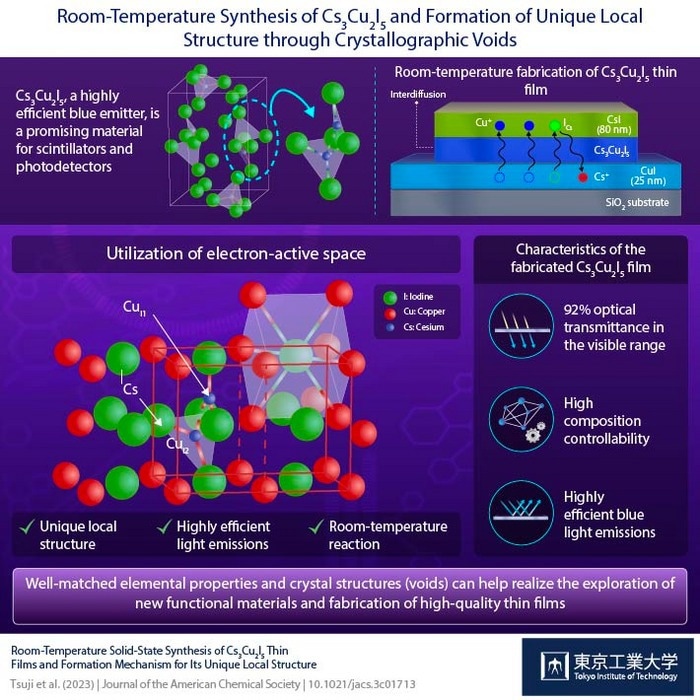High-quality components like metal halide phosphors, which are capable of efficiently converting light into quantifiable signals, are needed for advanced electronic systems. This is where copper-based iodides without toxic elements, such as cesium copper iodide (Cs3Cu2I5: CCI), are particularly promising.

Image Credit: Tokyo Tech
For use in deep-UV photodetectors and -ray scintillators for detecting ionizing radiation, such as gamma or X-Rays, CCI is an effective blue light-emitting material that can convert nearly all the absorbed energy into detectable light.
The CCI thin films, however, fall short of the necessary quality requirements, which limits their ability to perform well in sophisticated stacking applications.
A unique technique for creating superior Cs3Cu2I5 thin films has now been proposed in a study that was published in the Journal of the American Chemical Society.
Researchers from the Tokyo Institute of Technology (Tokyo Tech) were in charge of the study; Professor Masatake Tsuji served as the first author, and Specially Appointed Assistant Professor Hideo Hosono served as the corresponding author.
The group had previously found via experimentation that powders of cesium iodide (CsI) and copper iodide (CuI) can combine even at room temperature to create Cs3Cu2I5. Based on this realization, they evaporated CuI and CsI thin films in a vacuum chamber and then deposited them as thin films onto a silica substrate.
To create transparent, extremely smooth films with a high optical transmittance (T) of 92%, the two films were then allowed to react at ambient temperature.
Interestingly, the researchers discovered that the crystalline phases that developed depended on the sequence in which the layers were placed. They discovered that the equilibrium phase under this thickness ratio condition was created when a CsI layer was deposited over a CuI layer, producing a thin film of Cs3Cu2I5 that emits blue light.
The consequence of depositing CuI over CsI, on the other hand, was a thin coating of CsCu2I3 that emitted yellow light. It was determined that the interdiffusion of Cs and Cu atoms between the two layers was what caused the creation of these various phases.
Based on these findings, the researchers discovered that each phase’s creation could be regulated by merely altering the thickness of each film to achieve a certain CsI to CuI ratio.
According to the researchers, the interdiffusion process results in the production of distinctive local structures with point defects that, following photoexcitation, degrade through nonradiative channels to produce extremely effective emissions.
We propose that this formation originates from the rapid diffusion of Cu+ and I− ions into CsI crystals along with the formation of I− at the Cs+ site and interstitial Cu+ in the CsI lattice.
Hideo Hosono, Study Corresponding Author and Professor, Tokyo Institute of Technology
The asymmetric [Cu2I5]3– polyhedron iodocuprate anion, which is made up of the edge-shared CuI3 triangle and the CuI4 tetrahedron dimer that is isolated by Cs+ ions, is the source of the photoluminescent capabilities of Cs3Cu2I5.
By selectively depositing a CsI layer through a shadow mask, the researchers were able to create patterned thin films using this method. As a result, they were able to regulate the CsI deposition and only design the substrate’s desired regions.
They were able to effectively create a film with a center blue light-emitting Cs3Cu2I5 area flanked by a yellow light-emitting CsCu2I3 region by carefully regulating the thickness of the CuI and CsI layers.
Furthermore, for future applications, they proved that the same thin films could be made by employing solution-processed CuI and patterned CsI thin films.
Prof. Hosono concluded, “Our study explains the mechanism underlying the formation of the rare local structures in Cs3Cu2I5 and its association with photoluminescence in these materials. These results can ultimately pave the way for the development of high-quality thin film devices with ideal optical properties for advanced stacking applications.”
Journal Reference
Tsuji, M., et al. (2023) Room-Temperature Solid-State Synthesis of Cs3Cu2I5 Thin Films and Formation Mechanism for Its Unique Local Structure. Journal of the American Chemical Society. doi:10.1021/jacs.3c01713
Source: https://www.titech.ac.jp/english